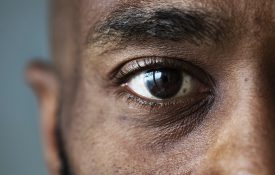-
So You Flunked A Racism Test. Now What?
NPR: You're probably at least a little bit racist and sexist and homophobic. Most of us are. Before you get all indignant, try taking one of the popular implicit-association tests. Created by sociologists at Harvard, the University of Washington, and the University of Virginia, they measure people's unconscious prejudice by testing how easy — or difficult — it is for the test-takers to associate words like "good" and "bad" with images of black people versus white people, or "scientist" and "lab" with men versus women.
-

At Face Value: Certain Facial Features Inspire Trust
Chief executives with certain facial features are immediately assessed as more trustworthy, and are less likely to be blamed for a company’s financial problems, a study has found.
-

Look Into My Pupils: Pupil Mimicry May Lead to Increased Trust
People often mimic each other’s facial expressions without even knowing it, but research shows that they also mimic the size of each other’s pupils.
-
The Ordeal That Made Me a Student of Humanity
The Wall Street Journal: In 1984, as a 17-year-old high-school student in Israel, I was a member of a youth movement that focused on study, civic work and preparation for military service. Our graduation ceremonies often featured big fires, intended to dramatize our patriotic fervor. That year, some of our leaders had brought back military supplies to help make the blaze especially intense. One Friday afternoon, as we began putting away these materials, there was an accident. Nobody knows exactly what happened, but a spark must have been struck somewhere. A large magnesium flare—the kind that the Israeli military uses to light up a battlefield—exploded right next to me.
-
The Best Screen Time
Slate: BOSTON—The library in Boston’s Haynes Early Education Center is a bright, cheery space filled with well-stocked bookcases, tables ringed by small wooden chairs, art supplies, cushions for story time, and dozens of laminated vocabulary words strung below an oversize paper alphabet. But one of the most important learning tools here is a small gray box lit by a blinking green LED, perched well above kid-height on a yellow wall by the door. It’s the Wi-Fi transponder that brings broadband Internet to the fingertips of about 175 small children—preschool through first grade, mostly from low-income black and Hispanic families.
-
Bike Visibility Does Little to Change Drivers’ Dangerous Overtaking
A recent bill in the state of Wyoming would require all bicyclists to wear no less than 200 square inches “of high-visibility fluorescent orange, green or pink color clothing visible from the front and rear of the bicycle.” Though lawmakers in favor the bill argued that the new wardrobe requirements were for bicyclists’ own safety, research on driver behavior doesn’t necessarily back this up. In fact, new research is showing that “high-vis” clothing is not as effective at increasing bicycle safety as is often assumed. A study by University of Bath psychological scientist Ian Walker finds that high-visibility clothing is unlikely to prevent the most dangerous passing behavior from drivers.

